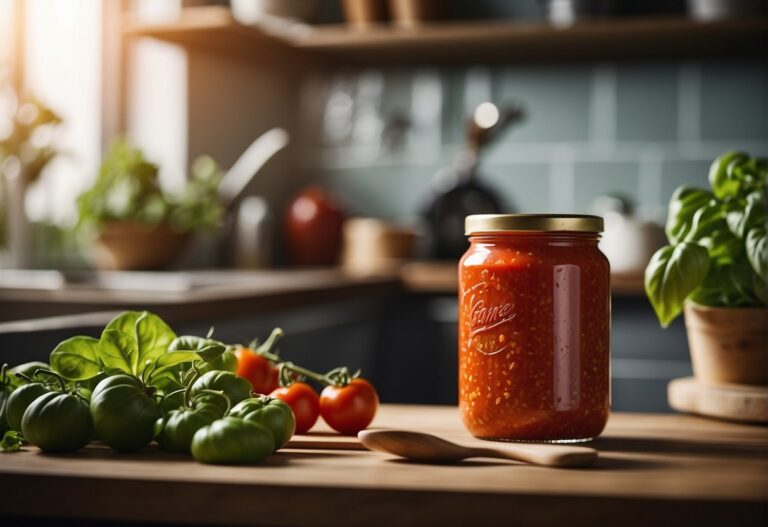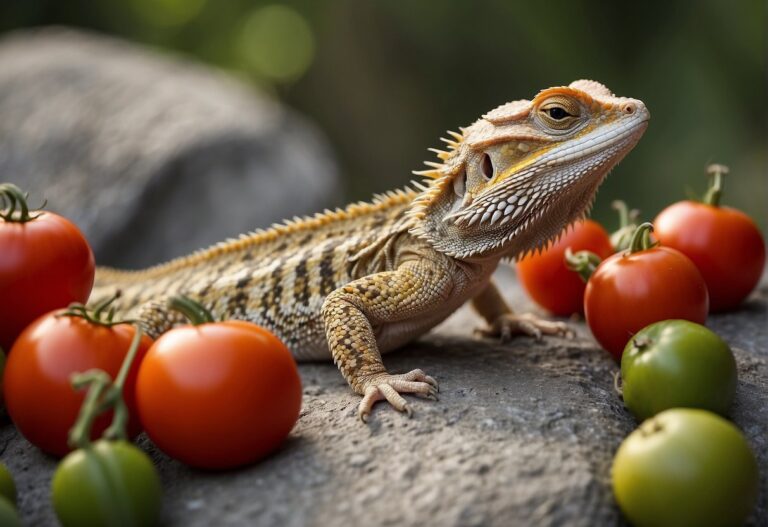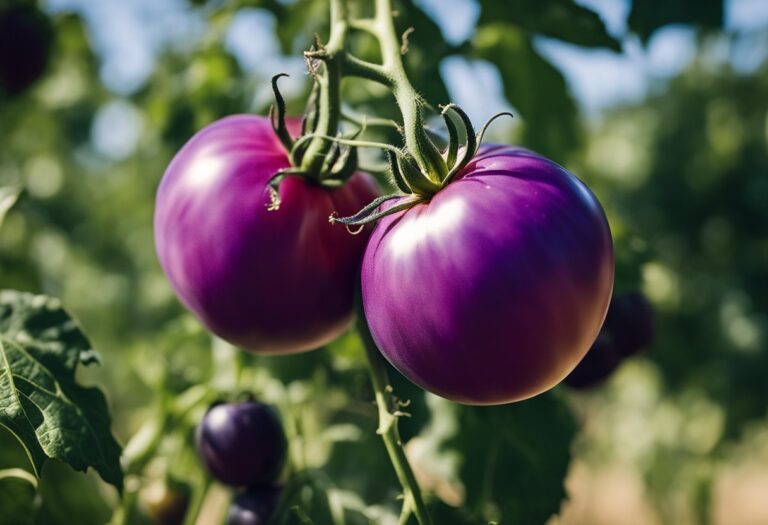Brandywine Tomato: A Guide to Cultivation and Culinary Uses
Brandywine tomatoes are among the most beloved heirloom varieties. Known for their sweet and juicy flavor, they have a rich history that dates back to the 19th century. Whether you are an experienced gardener or just starting, the Brandywine tomato is rewarding to grow.
Growing these tomatoes not only adds color to your garden but also offers a variety of culinary uses. From fresh salads to savory sauces, their unique taste can enhance many dishes. With the right techniques in planting and care, you can enjoy a bountiful harvest of these large and meaty tomatoes.
Key Takeaways
- Brandywine tomatoes are known for their exceptional flavor and rich history.
- You can successfully grow them with simple cultivation techniques.
- They have versatile uses in cooking and can elevate many recipes.
History of Brandywine Tomatoes
Brandywine tomatoes have a rich history, rooted in American agriculture. They are valued for their unique flavor and heirloom status, making them popular among gardeners and chefs alike. This section explores their origins and the development of different cultivars.
Origins and Heirloom Status
Brandywine tomatoes are believed to have originated in the late 1800s in Chester County, Pennsylvania. They were named after the Brandywine River, which flows through this region. The first introduction to the public occurred in 1882 by a farmer named Johnson Stokes, who sold the seeds.
As heirloom tomatoes, Brandywines are open-pollinated and have been passed down through generations. This means they maintain their characteristics without genetic modification. Their heirloom status contributes to both their historical importance and popularity among gardeners who appreciate traditional varieties.
Cultivar Development
Over the years, several cultivars of Brandywine tomatoes have been developed, each with distinct traits. Among them, the Brandywine Sudduth variety, known for its pink color and rich flavor, is often cited as one of the tastiest tomatoes available.
Another notable cultivar is the Brandywine Red, which features a more classic red hue. Growers often select specific traits, such as size, flavor, or disease resistance, leading to a range of options for gardeners. This diversity allows you to choose the variety that best suits your gardening needs.
Cultivation Techniques
Growing Brandywine tomatoes successfully requires attention to soil, sunlight, watering, and pest management. Each factor plays a crucial role in ensuring healthy plants and a tasty harvest.
Soil Requirements
Brandywine tomatoes thrive in well-drained, fertile soil that is rich in organic matter. You should aim for a slightly acidic pH, ideally between 6.0 and 6.8. Before planting, work in several inches of compost or aged manure to improve soil structure and nutrients.
A mixture of loamy soil can help retain moisture while allowing excess water to drain away. This balance prevents root rot and promotes strong plant growth. Regularly testing your soil can help you maintain optimal conditions for these heirloom varieties.
Sunlight and Watering Needs
Brandywine tomatoes need full sun, requiring at least six to eight hours of direct sunlight each day. Plant them in a location that receives ample light to encourage healthy growth and fruit production.
Water your plants consistently, providing about one to two inches of moisture each week. You may need to adjust this based on rainfall. It’s best to water deeply and less frequently to promote deep root development. Avoid watering on the leaves to minimize the risk of fungal diseases.
Common Pests and Diseases
Pests such as aphids, whiteflies, and spider mites can affect your Brandywine tomatoes. Regularly inspect the plants for any signs of infestation. If you notice pests, consider using insecticidal soap or neem oil to control them.
You should also be aware of diseases like blossom end rot, blight, and fusarium wilt. Ensure good air circulation and do not overcrowd your plants. Crop rotation and removing infected leaves can help manage diseases. Applying mulch around your plants may also protect them from soil-borne pests and diseases.
Nutritional Profile
Brandywine tomatoes are not only delicious but also packed with essential nutrients. Understanding their health benefits and dietary uses can help you incorporate them effectively into your meals.
Health Benefits
Brandywine tomatoes offer several health benefits. They are low in calories, making them a great option for weight management. A one-cup serving provides about 30 calories, allowing you to enjoy them guilt-free.
These tomatoes are rich in vitamin C, which supports your immune system and promotes healthy skin. They also contain lycopene, an antioxidant linked to reduced risk of chronic diseases, such as heart disease and certain cancers.
Additionally, Brandywine tomatoes provide fiber that aids digestion and keeps you feeling full longer. Regular consumption can contribute to overall digestive health while supporting cardiovascular wellness.
Dietary Uses
You can enjoy Brandywine tomatoes in various ways, enhancing both flavor and nutrition in your meals. Their robust taste makes them perfect for salads, sandwiches, and salsas.
Consider roasting them to bring out their natural sweetness or adding them to pasta dishes for extra flavor. They can also be used in soups and sauces, providing a thick, rich base.
When planning your meals, think about including Brandywine tomatoes in different recipes. They pair well with herbs such as basil and oregano. This versatility makes them a wonderful addition to your diet, ensuring you benefit from their nutritional value and taste.
Culinary Applications
Brandywine tomatoes are known for their unique flavor and versatility in various dishes. They can elevate the taste of many recipes due to their rich, juicy consistency and robust flavor.
Flavor Profile
Brandywine tomatoes have a sweet, tangy taste with a subtle earthiness. Their flesh is dense and meaty, which makes them excellent for various culinary uses. The skins are thick, providing a satisfying bite and preserving the tomato’s moisture.
Their flavor intensity can vary slightly based on ripeness. A perfectly ripe Brandywine tomato will have a balanced sweetness and acidity, enhancing salads and main dishes alike. The color ranges from pink to yellowish-orange, each bringing a different, delightful taste experience that complements many ingredients.
Recipe Recommendations
You can use Brandywine tomatoes in numerous dishes. Here are some popular ideas:
- Fresh Salads: Dice Brandywine tomatoes and toss them in a salad with mixed greens, cucumbers, and a light vinaigrette.
- Sandwiches: Use thick slices in sandwiches or burgers for added flavor and moisture.
- Salsas: Chop them into salsas with onions, peppers, and cilantro for a refreshing topping.
- Sauces: Cook down for homemade pasta sauces, where their sweetness shines through.
By incorporating Brandywine tomatoes into your meals, you can enjoy fresh, flavorful dishes that highlight the best qualities of this heirloom variety.
Harvesting and Storage
Proper harvesting and storage methods are essential for maintaining the quality of Brandywine tomatoes. You want to ensure that you harvest them at the right time and store them correctly to extend their freshness.
Best Practices for Harvesting
To harvest Brandywine tomatoes, wait until they are fully ripe. This typically occurs 80 to 100 days after planting. Ripe tomatoes have a rich color and yield slightly to gentle pressure.
When you are ready to pick, gently grasp the stem and twist to detach the fruit. Use garden shears if the stems are tough. Avoid pulling the tomatoes roughly, as this can damage the plant.
If you see any signs of pest damage or disease, prioritize picking the affected tomatoes. This helps prevent spreading issues to healthy fruits.
Long-term Storage Tips
To store Brandywine tomatoes effectively, keep them in a cool, dark place. A pantry or cellar works best. Avoid refrigeration, as it can alter the flavor and texture.
If you’ve harvested more than you can eat, consider saving seeds. To do this, ferment the seeds, rinse them, and let them dry. Store the seeds in a cool spot for future planting.
Lastly, check your stored tomatoes regularly. Remove any that show signs of spoilage to prevent them from affecting others. Proper care will help keep your Brandywine tomatoes fresh longer.
Frequently Asked Questions
Brandywine tomatoes are a popular choice among gardeners and chefs alike. This section addresses common questions about their flavor, growth, varieties, and culinary uses.
What are the flavor characteristics of Brandywine tomatoes?
Brandywine tomatoes are known for their rich and complex flavor. They have a sweet, tangy taste that sets them apart from many other varieties. Their juicy flesh makes them perfect for fresh eating or cooking.
Are Brandywine tomatoes classified as determinate or indeterminate?
Brandywine tomatoes are generally classified as indeterminate. This means they will continue to grow and produce fruit throughout the season, requiring support as they can grow quite tall.
What is the difference between pink and red Brandywine tomatoes?
The primary difference between pink and red Brandywine tomatoes lies in their color and flavor nuances. Pink Brandywines tend to have a slightly sweeter taste, while red varieties offer a bolder flavor. Both are prized for their quality.
How should Brandywine tomatoes be supported during growth?
To support Brandywine tomatoes as they grow, use cages or stakes. These methods help keep the plants upright and allow for better air circulation and sunlight exposure. Proper support can reduce the risk of disease.
Where can one purchase Brandywine tomato seeds or plants?
You can find Brandywine tomato seeds or plants at local garden centers, nurseries, and online retailers. Many specialty seed companies also offer different varieties of Brandywine tomatoes, ensuring a good selection.
What culinary uses are Brandywine tomatoes best suited for?
Brandywine tomatoes are quite versatile in the kitchen. They work well in salads, sauces, and sandwiches. Their rich flavor makes them ideal for fresh dishes or when cooked into soups and stews.



